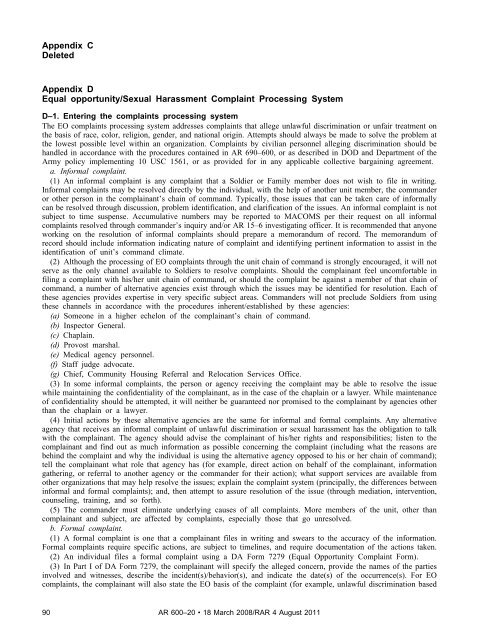AR 600-20, Army Command Policy - Army Publishing Directorate ...
AR 600-20, Army Command Policy - Army Publishing Directorate ...
AR 600-20, Army Command Policy - Army Publishing Directorate ...
Create successful ePaper yourself
Turn your PDF publications into a flip-book with our unique Google optimized e-Paper software.
Appendix C<br />
Deleted<br />
Appendix D<br />
Equal opportunity/Sexual Harassment Complaint Processing System<br />
D–1. Entering the complaints processing system<br />
The EO complaints processing system addresses complaints that allege unlawful discrimination or unfair treatment on<br />
the basis of race, color, religion, gender, and national origin. Attempts should always be made to solve the problem at<br />
the lowest possible level within an organization. Complaints by civilian personnel alleging discrimination should be<br />
handled in accordance with the procedures contained in <strong>AR</strong> 690–<strong>600</strong>, or as described in DOD and Department of the<br />
<strong>Army</strong> policy implementing 10 USC 1561, or as provided for in any applicable collective bargaining agreement.<br />
a. Informal complaint.<br />
(1) An informal complaint is any complaint that a Soldier or Family member does not wish to file in writing.<br />
Informal complaints may be resolved directly by the individual, with the help of another unit member, the commander<br />
or other person in the complainant’s chain of command. Typically, those issues that can be taken care of informally<br />
can be resolved through discussion, problem identification, and clarification of the issues. An informal complaint is not<br />
subject to time suspense. Accumulative numbers may be reported to MACOMS per their request on all informal<br />
complaints resolved through commander’s inquiry and/or <strong>AR</strong> 15–6 investigating officer. It is recommended that anyone<br />
working on the resolution of informal complaints should prepare a memorandum of record. The memorandum of<br />
record should include information indicating nature of complaint and identifying pertinent information to assist in the<br />
identification of unit’s command climate.<br />
(2) Although the processing of EO complaints through the unit chain of command is strongly encouraged, it will not<br />
serve as the only channel available to Soldiers to resolve complaints. Should the complainant feel uncomfortable in<br />
filing a complaint with his/her unit chain of command, or should the complaint be against a member of that chain of<br />
command, a number of alternative agencies exist through which the issues may be identified for resolution. Each of<br />
these agencies provides expertise in very specific subject areas. <strong>Command</strong>ers will not preclude Soldiers from using<br />
these channels in accordance with the procedures inherent/established by these agencies:<br />
(a) Someone in a higher echelon of the complainant’s chain of command.<br />
(b) Inspector General.<br />
(c) Chaplain.<br />
(d) Provost marshal.<br />
(e) Medical agency personnel.<br />
(f) Staff judge advocate.<br />
(g) Chief, Community Housing Referral and Relocation Services Office.<br />
(3) In some informal complaints, the person or agency receiving the complaint may be able to resolve the issue<br />
while maintaining the confidentiality of the complainant, as in the case of the chaplain or a lawyer. While maintenance<br />
of confidentiality should be attempted, it will neither be guaranteed nor promised to the complainant by agencies other<br />
than the chaplain or a lawyer.<br />
(4) Initial actions by these alternative agencies are the same for informal and formal complaints. Any alternative<br />
agency that receives an informal complaint of unlawful discrimination or sexual harassment has the obligation to talk<br />
with the complainant. The agency should advise the complainant of his/her rights and responsibilities; listen to the<br />
complainant and find out as much information as possible concerning the complaint (including what the reasons are<br />
behind the complaint and why the individual is using the alternative agency opposed to his or her chain of command);<br />
tell the complainant what role that agency has (for example, direct action on behalf of the complainant, information<br />
gathering, or referral to another agency or the commander for their action); what support services are available from<br />
other organizations that may help resolve the issues; explain the complaint system (principally, the differences between<br />
informal and formal complaints); and, then attempt to assure resolution of the issue (through mediation, intervention,<br />
counseling, training, and so forth).<br />
(5) The commander must eliminate underlying causes of all complaints. More members of the unit, other than<br />
complainant and subject, are affected by complaints, especially those that go unresolved.<br />
b. Formal complaint.<br />
(1) A formal complaint is one that a complainant files in writing and swears to the accuracy of the information.<br />
Formal complaints require specific actions, are subject to timelines, and require documentation of the actions taken.<br />
(2) An individual files a formal complaint using a DA Form 7279 (Equal Opportunity Complaint Form).<br />
(3) In Part I of DA Form 7279, the complainant will specify the alleged concern, provide the names of the parties<br />
involved and witnesses, describe the incident(s)/behavior(s), and indicate the date(s) of the occurrence(s). For EO<br />
complaints, the complainant will also state the EO basis of the complaint (for example, unlawful discrimination based<br />
90 <strong>AR</strong> <strong>600</strong>–<strong>20</strong> 18 March <strong>20</strong>08/R<strong>AR</strong> 4 August <strong>20</strong>11
















